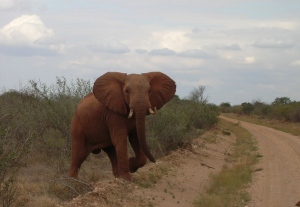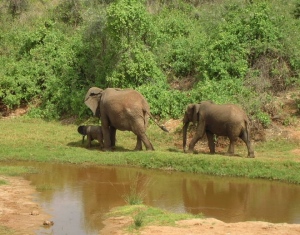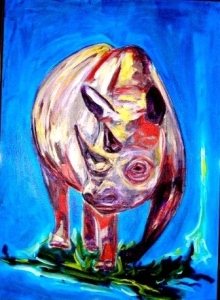
Startled Bull Elephant Chases our Land Rover.
An Elephant Never Forgets
A number of years ago I participated in an Earthwatch research project at Tsavo National Park in Kenya under the tutelage of Dr. Barbara McKnight. For several weeks I lived and breathed elephants, tracking from our rugged Land Rover a portion of the 11,600 behemoths still traveling through the 21,000 km preserve. Since the area also contained baboons, lions, wart hogs, giraffes, zebras, hippopotamus, enormous venomous snakes, and rhinoceros to name a few, we were confined to our vehicle, and even instructed to pee quickly behind the SUV.
Eight hours a day we followed these beautiful creatures as they lumbered in family groups, trailing the matriarch from watering hole to feeding ground. We documented the herds by recording their size, direction of travel, antics, postures, and eating habits. Ear notches and scars told us which animals were returning to various locations. We recorded plants, listed birds and creatures nearby, including goats and cattle illegally encroaching on the parkland.

Most fun was watching playful baby elephants piling one on top of another, rolling off to scamper around their resting site. If they roamed too far away they were firmly nudged back to their mothers by a nearby female. When the herd took their hour nap, calves were placed in the center of a ring of outward facing adult cows. Eventually the matriarch would signal it was time to continue marching over the land to cover as much as 50 miles a day.
During the birthing process the entire herd will surround the laboring cow. Once her calf is born they trumpet with joy, taking turns touching the newborn with their trunks in greeting. The entire herd then becomes responsible for the safety and education of the newborn. While traveling the baby is placed between the protective legs of its mother. In case of death, the cow morns for days by standing over her calf’s body, covering it with twigs and leaves while other members of the herd visit to give comfort. The depressed mother knows it has to leave to find food and water, but as she does so she carries a trail of sadness.
At times we observed young bull elephants, recently ejected from the herd, traveling closely behind their mothers. More often we came across older bulls foraging alone. Once when we accidentally startled a bull, our vehicle was charged, much to the great fear of Dr. McKnight who backed away as fast as she could. Not understanding the danger, I could see fear in her eyes and sweat dripping from her face. When I originally went on this adventure, I had expected to return as a zoo volunteer, but after observing elephants in the wild, I was horrified at their condition in captivity.
And…I learned, that elephants never forget. They live up to 60 years in the wild, and their amazing memory is the key to their survival. According to Scientific American, “scientists now have solid evidence that elephants are just as brilliant as they are big: They are adept tool users and cooperative problem solvers; they are highly empathic, comforting one another when upset; and they probably do have a sense of self.” Their 10.5 pound brain is used to encode survival details of alternative routes to use in case of drought. They recognize faces of other elephants they may have come in contact with during periodic multi-herd gatherings. Though their eyesight is fair their sense of smell and touch are strong. By smelling urine they notice unfamiliar elephants who could potentially cause trouble.
An elephant’s memory develops with age and experience, but unfortunately the older animals are the ones poachers are likely to kill, leaving the remaining herd at great disadvantage. Youngsters watch in horror when their families are slaughtered and remember forever the faces of perpetrators. What the herd loses is the matriarch’s memory of survival routes. 35,000 elephants are slaughtered by ivory poachers each year, and these mass killings can turn otherwise nonviolent elephants into dangerous animals.
In captivity elephants recognize their trainers and those who care for them. Many zoos involved in protecting the species are starting to see elephants from their own perspective. In Portland, the Oregon Zoo is expanding its elephant area to 6 acres, a pittance for their needs, but far better than before. Food dolled out randomly at multiple sites will compel the elephants to explore in order to find their next meal. I am excited by the new enclosure opening in spring of 2015. It is about time. Perhaps I will volunteer after all.
 Rhino Marching
Rhino Marching
Tsavo National Park had it all
I look forward to your comments.
For more information about Elephants:
http://www.scientificamerican.com/article/elephants-never-forget/ – Scientific American article Fact of Fiction?: Elephants Never Forget.
http://voices.nationalgeographic.com/2013/01/16/ivory-poaching-threatens-elephant-memory/ National Geographic – Ivory-poaching-threatens-elephant-memory
http://www.scientificamerican.com/article/the-science-is-in-elephants-are-even-smarter-than-we-realized-video/ Elephants Are Even Smarter Than We Realized.
http://mentalfloss.com/article/52381/it-true-elephants-never-forget – Mental Floss, About memory and Elephants.
http://www.wildize.org/projects/Wildlife-Security/Tsavo-Elephant-Research-TER-Dr-Barbara-McKnight/56 – About Research at Tsavo National Park.
Home » Blog » An Elephant Never Forgets
Table of Contents
Startled Bull Elephant Chases our Land Rover.
An Elephant Never Forgets
A number of years ago I participated in an Earthwatch research project at Tsavo National Park in Kenya under the tutelage of Dr. Barbara McKnight. For several weeks I lived and breathed elephants, tracking from our rugged Land Rover a portion of the 11,600 behemoths still traveling through the 21,000 km preserve. Since the area also contained baboons, lions, wart hogs, giraffes, zebras, hippopotamus, enormous venomous snakes, and rhinoceros to name a few, we were confined to our vehicle, and even instructed to pee quickly behind the SUV.
Eight hours a day we followed these beautiful creatures as they lumbered in family groups, trailing the matriarch from watering hole to feeding ground. We documented the herds by recording their size, direction of travel, antics, postures, and eating habits. Ear notches and scars told us which animals were returning to various locations. We recorded plants, listed birds and creatures nearby, including goats and cattle illegally encroaching on the parkland.
Most fun was watching playful baby elephants piling one on top of another, rolling off to scamper around their resting site. If they roamed too far away they were firmly nudged back to their mothers by a nearby female. When the herd took their hour nap, calves were placed in the center of a ring of outward facing adult cows. Eventually the matriarch would signal it was time to continue marching over the land to cover as much as 50 miles a day.
During the birthing process the entire herd will surround the laboring cow. Once her calf is born they trumpet with joy, taking turns touching the newborn with their trunks in greeting. The entire herd then becomes responsible for the safety and education of the newborn. While traveling the baby is placed between the protective legs of its mother. In case of death, the cow morns for days by standing over her calf’s body, covering it with twigs and leaves while other members of the herd visit to give comfort. The depressed mother knows it has to leave to find food and water, but as she does so she carries a trail of sadness.
At times we observed young bull elephants, recently ejected from the herd, traveling closely behind their mothers. More often we came across older bulls foraging alone. Once when we accidentally startled a bull, our vehicle was charged, much to the great fear of Dr. McKnight who backed away as fast as she could. Not understanding the danger, I could see fear in her eyes and sweat dripping from her face. When I originally went on this adventure, I had expected to return as a zoo volunteer, but after observing elephants in the wild, I was horrified at their condition in captivity.
And…I learned, that elephants never forget. They live up to 60 years in the wild, and their amazing memory is the key to their survival. According to Scientific American, “scientists now have solid evidence that elephants are just as brilliant as they are big: They are adept tool users and cooperative problem solvers; they are highly empathic, comforting one another when upset; and they probably do have a sense of self.” Their 10.5 pound brain is used to encode survival details of alternative routes to use in case of drought. They recognize faces of other elephants they may have come in contact with during periodic multi-herd gatherings. Though their eyesight is fair their sense of smell and touch are strong. By smelling urine they notice unfamiliar elephants who could potentially cause trouble.
An elephant’s memory develops with age and experience, but unfortunately the older animals are the ones poachers are likely to kill, leaving the remaining herd at great disadvantage. Youngsters watch in horror when their families are slaughtered and remember forever the faces of perpetrators. What the herd loses is the matriarch’s memory of survival routes. 35,000 elephants are slaughtered by ivory poachers each year, and these mass killings can turn otherwise nonviolent elephants into dangerous animals.
In captivity elephants recognize their trainers and those who care for them. Many zoos involved in protecting the species are starting to see elephants from their own perspective. In Portland, the Oregon Zoo is expanding its elephant area to 6 acres, a pittance for their needs, but far better than before. Food dolled out randomly at multiple sites will compel the elephants to explore in order to find their next meal. I am excited by the new enclosure opening in spring of 2015. It is about time. Perhaps I will volunteer after all.
Tsavo National Park had it all
I look forward to your comments.
For more information about Elephants:
http://www.scientificamerican.com/article/elephants-never-forget/ – Scientific American article Fact of Fiction?: Elephants Never Forget.
http://voices.nationalgeographic.com/2013/01/16/ivory-poaching-threatens-elephant-memory/ National Geographic – Ivory-poaching-threatens-elephant-memory
http://www.scientificamerican.com/article/the-science-is-in-elephants-are-even-smarter-than-we-realized-video/ Elephants Are Even Smarter Than We Realized.
http://mentalfloss.com/article/52381/it-true-elephants-never-forget – Mental Floss, About memory and Elephants.
http://www.wildize.org/projects/Wildlife-Security/Tsavo-Elephant-Research-TER-Dr-Barbara-McKnight/56 – About Research at Tsavo National Park.
Table of Contents